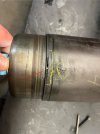wlhequipment
Senior Member
Hi folks,
I've worked on 4 or 5 of these old 300/400 series mechanical Deeres over the years and every one of em has failed for the same reason; the user put the wrong coolant in, and the cylinder liners cavitated. For the record, it's not a design flaw of the machine. I'm quite fond of these. I'd say it's more of a design flaw of the operator. In any case, I've been working on this 401C on and off for a few months, and I finally got it running and in the shop. This, like every other, had a pinhole in a liner. If not for that one tiny hole in that one liner, I wouldn't have torn into the engine, but that's where we are. The other 3 are showing cavitation "divots", but haven't worn through yet. Just the one. All holes / divots are down low on the sleeve, below compression rings. That's why the engine actually ran fine.
If this were a customer machine, I'd be pressed for time and would just inframe the thing, and get it out the door. But this machine is mine, and I'm in no rush, so I'm in the mood to experiment.
I'm wondering if I can repair these by brazing. Grind them down / clean em up a little, fill it in and turn it back down on the lathe. I wonder if it will work. Has anyone tried this? If the holes were above the rings, I don't think it would work. Or, if the sleeves were shagged, I wouldn't bother. The one hole is right where the top (square) oring would seat. So I'd have to fill it in, turn it down to the OD it was above that "shelf", and re-cut that "shelf" where the square ring seats.
I think I can be done. What do you think?
I've worked on 4 or 5 of these old 300/400 series mechanical Deeres over the years and every one of em has failed for the same reason; the user put the wrong coolant in, and the cylinder liners cavitated. For the record, it's not a design flaw of the machine. I'm quite fond of these. I'd say it's more of a design flaw of the operator. In any case, I've been working on this 401C on and off for a few months, and I finally got it running and in the shop. This, like every other, had a pinhole in a liner. If not for that one tiny hole in that one liner, I wouldn't have torn into the engine, but that's where we are. The other 3 are showing cavitation "divots", but haven't worn through yet. Just the one. All holes / divots are down low on the sleeve, below compression rings. That's why the engine actually ran fine.
If this were a customer machine, I'd be pressed for time and would just inframe the thing, and get it out the door. But this machine is mine, and I'm in no rush, so I'm in the mood to experiment.
I'm wondering if I can repair these by brazing. Grind them down / clean em up a little, fill it in and turn it back down on the lathe. I wonder if it will work. Has anyone tried this? If the holes were above the rings, I don't think it would work. Or, if the sleeves were shagged, I wouldn't bother. The one hole is right where the top (square) oring would seat. So I'd have to fill it in, turn it down to the OD it was above that "shelf", and re-cut that "shelf" where the square ring seats.
I think I can be done. What do you think?

